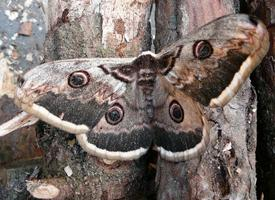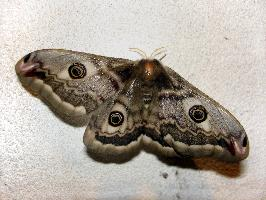
Descrierea animalului
The Giant Peacock Moth (Saturnia pyri), known for its stunning beauty and impressive size, stands as the largest moth native to Europe. This remarkable species, belonging to the family Saturniidae, captivates the attention of both scientists and nature enthusiasts alike with its unique characteristics and behaviors.With a wingspan reaching up to 15 centimeters (about 6 inches), the Giant Peacock Moth easily dwarfs other European moth species. The moth's wings are a canvas of rich, intricate patterns and vibrant colors. The upper side of the wings exhibits a mesmerizing mix of gray, brown, and white hues, beautifully arranged in a way that provides excellent camouflage against tree bark and other natural backgrounds. However, it's the eyespots on the wings that truly captivate the observer. These large, circular markings mimic the eyes of a predator, serving as an effective deterrent against potential threats. The eyespots on the hindwings are particularly striking, with their bright blue and black coloring surrounded by rings of yellow and white, resembling the tail feathers of a peacock, hence the moth's name.
The life cycle of the Giant Peacock Moth is as fascinating as its appearance. The moth emerges from its cocoon in late spring, with the breeding season typically spanning from April to June, depending on the geographical location. Males are known for their exceptional ability to detect pheromones released by females, sometimes from several kilometers away, thanks to their large, feathery antennae. This remarkable sense of smell facilitates mating rituals that occur during the night.
Females lay their eggs on a variety of host plants, with preference given to fruit trees such as apple, cherry, and plum. After about 10 days, the eggs hatch into larvae, which are equally impressive in their appearance. The caterpillars are a vibrant green with tubercles that are blue and yellow, adorned with hairs that give them a somewhat spiky appearance. As they grow, the caterpillars feed voraciously on the leaves of their host plants, preparing for the next stage of their life cycle.
After several molts, the caterpillar weaves a cocoon in which it will transform into a pupa. This stage can last through the winter, with the adult moth emerging the following spring to continue the cycle. It's interesting to note that adult Giant Peacock Moths do not feed; their mouthparts are underdeveloped, and their lifespan as adults is only about a week, during which their sole purpose is to reproduce.
The Giant Peacock Moth's habitat spans across Europe and into parts of the Middle East and North Africa. They prefer temperate environments and are commonly found in orchards, vineyards, and mixed forests, where their host plants are abundant.
Despite their size and beauty, Giant Peacock Moths are elusive and not commonly seen by the average person. Their nocturnal nature and brief adult lifespan contribute to their mysterious aura. However, for those lucky enough to encounter one of these magnificent creatures, the experience is unforgettable, offering a glimpse into the incredible diversity and complexity of the natural world.
Harta răspândirii

Animale similare
Fotografii noi cu animale
Top 10 animale
- Dolphin gull (Leucophaeus scoresbii)
- Diana monkey (Cercopithecus diana)
- Moustached guenon (Cercopithecus cephus)
- Greek tortoise (Testudo graeca)
- Stone loach (Barbatula barbatula)
- Galápagos tortoise (Geochelone nigra complex)
- Japanese macaque (Macaca fuscata)
- Russian tortoise (Testudo horsfieldii)
- Common flying dragon (Draco volans)
- Galápagos penguin (Spheniscus mendiculus)

